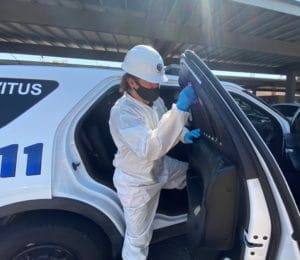Accidents happen! It’s hard to control them. And as many accidents may happen, there may be blood or body fluid spill to clean.
It is vital to know that blood is one of the most hazardous substances to clean up and thus should not be taken lightly. Hence, it is important to have knowledge of steps to clean up the blood safely, if any accident or trauma occurs.
To reduce the risk of contact with bloodborne pathogens such as human immunodeficiency virus (HIV), and hepatitis, any situation that includes blood or body fluids should be handled with extreme caution. Instead of just wiping it off or cleaning it with a damp cloth, you should act with caution.
If you’re not aware of how to clean up blood spills, take a moment and read this guide.
This article offers a 3-Round-Cleaning process for safe and thorough blood cleanup. Let’s have a look!
Must-Have Stuff For Safe Blood Cleanup
Blood and body fluids are two of the most potentially infectious materials (PIM). So to clean them having the required materials on hand will help ensure you do all safely.
● First, Personal protective equipment (PPE), including latex gloves, face shield, goggles, and coveralls
● Registered disinfectant material with a broad spectrum kill claim
● Labeled biohazard bags
● Disposable paper towels or cloths
Safely Clean Up Blood In 3 Rounds
You can begin the blood cleanup once you have the required materials.
– First Round
The first step is to cover the spill with towels and wait for them to soak up as much blood as possible. To somewhat speed up the process, you can put some weight on the towels. However, don’t use your hands to press the cloths/towel napkins – use objects instead.
– Second Round
Since the towels have soaked up the larger part of the spill, you now need to use a disinfectant. Apply the solution to the spill area and allow it to settle for at least 10 minutes. You can even leave it to stay for longer based on the size and nature of the spill. Now you can start scrubbing the area from the outside toward the center with a towel once ten minutes have elapsed. After you’re finished scrubbing, dispose of the towels by putting them in a biohazard bag.
– Third Round
In the third and final step, you need to get rid of any residue left. But before that, let the spill sit for about 10-15 minutes and then treat it again with damp towels. This way, you will get rid of any residue left as well as any leftover disinfectant solution. Again, dispose-off the towels into a biohazard bag.
In the overall method, be sure to dispose-off the clothes and towels you are using. Besides, put your tools and your protective equipment carefully into a plastic bag and label it “biohazard.”Correspondingly, make sure that no other areas were contaminated during the whole procedure.
ProTip: Don’t attempt to decontaminate the towels, nor the equipment. The best course of procedure is to get rid of each used material by placing it into biohazard bags.
On top of that, wash your hands with disinfectant soap and warm water and take a shower.
Think About Hiring Professionals Instead
If you’re looking for an easy answer to the question of how to clean up blood, don’t think twice, try the forementioned 3-round-cleaning procedure as it will, in most cases, work seamlessly.
However, there are chances that you won’t get the much-required PPE or Registered disinfectant material with a broad spectrum kill claim. But Professionals have that all.
Also, if you’re dealing with contamination of a more serious magnitude, you should only hire a team of experts instead of dealing with it yourself.
The professionals are generally trained to handle a wide range of blood cleaning and trauma situations, including homicides and suicides, transportation and industrial accidents, and even mass trauma. Plus, they approach blood cleanup with a scientific process to contain, sanitize, and fully remediate all potential blood-borne pathogens from places, which is a must, especially for blood cleanups.
Choose Safe, Be Safe!

